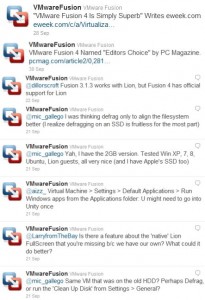
- #Parallels desktop for mac vs vmware fusion install#
- #Parallels desktop for mac vs vmware fusion upgrade#
- #Parallels desktop for mac vs vmware fusion pro#
Testing creating a few other drives all exhibited similarly terrible performance. Creating a pre-allocated 60GB disk this morning took almost an hour. When creating pre-allocated disks, Parallels is at least twice as fast as Fusion.The Linux guest wouldn’t even get past the LILO prompt. The Windows 2003 guest went through a non-stop boot cycle where after 5 seconds or so of booting it would reset. I tried to use VMware’s import utility this morning on both a Windows 2003 guest and a Linux guest and both were completely unusable. Not once did I have a problem with “standard” machines. For standard Linux and Windows guests, I’ve imported at least 30 different machines from VMware ESX and VMware Server hosted environments into Parallels Desktop.It’s distracting and I can live with it, but it’s pretty shoddy. I’m talking seamless window movement in Coherence, with noticeable ghosting in Unity. Even under Parallels Desktop v4, Coherence mode was significantly faster than Unity.(Maybe Coherence in v5 works better … oops, no, wait, it doesn’t work at all for multiple monitors so I can’t even begin to think that.)Īreas where Parallels kicks Fusion’s Butt: This means that it can run across the middle of the secondary monitor, depending on how your monitors are layed out. Coherence, when it extends across multiple monitors, extends the Windows Task Bar across multiple monitors in the same position. VMware’s Unity feature extends across multiple monitors in a way that doesn’t suck.
#Parallels desktop for mac vs vmware fusion install#
(For the above reason, I suspect, though I’ve not yet had time to test, that I’ll be able to install all the other cool demos I’ve got sitting on a spare drive).VMware Fusion will happily install ESX as a guest machine.VMware’s Unity feature actually merges Coherence and Crystal without needing to just drop all barriers between the VM and the host.

#Parallels desktop for mac vs vmware fusion pro#
As I only have one VM on my Mac Book Pro, as opposed to 34 on my Mac Pro, I felt that testing Fusion out on my Mac Book Pro to start with would be a good idea.
#Parallels desktop for mac vs vmware fusion upgrade#
With the recent upgrade to Parallels v5 being a mixed bag (much better performance, Coherence broken for 3+ weeks whenever multiple monitors are attached), on Thursday I decided I’d had enough and felt it was time to start at least trying VMware Fusion.

(Honestly, PC server manufacturers just don’t even try to make their systems quiet. While this wasn’t previously an issue having an ESX server in my lab, I’ve slowly become less tolerant of noisy computers and so it’s been less desirable to have on – part of the reason why I went out and bought a Mac Pro. Unfortunately these are usually heavily geared towards running within a VMware hosted environment, and rarely if ever port across to Parallels. As an employee of an EMC partner, I periodically get access to nifty demos as VMs.


 0 kommentar(er)
0 kommentar(er)
